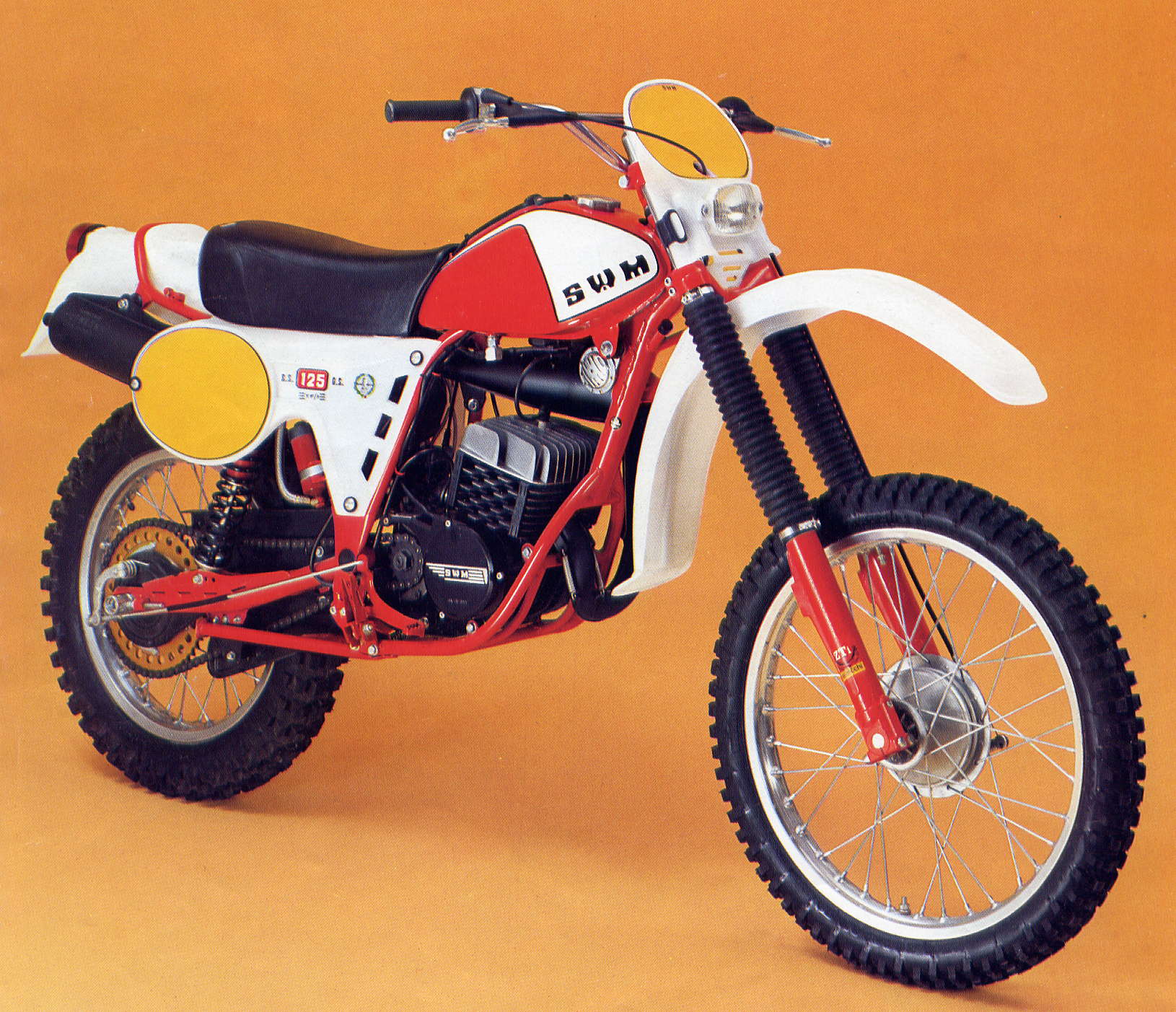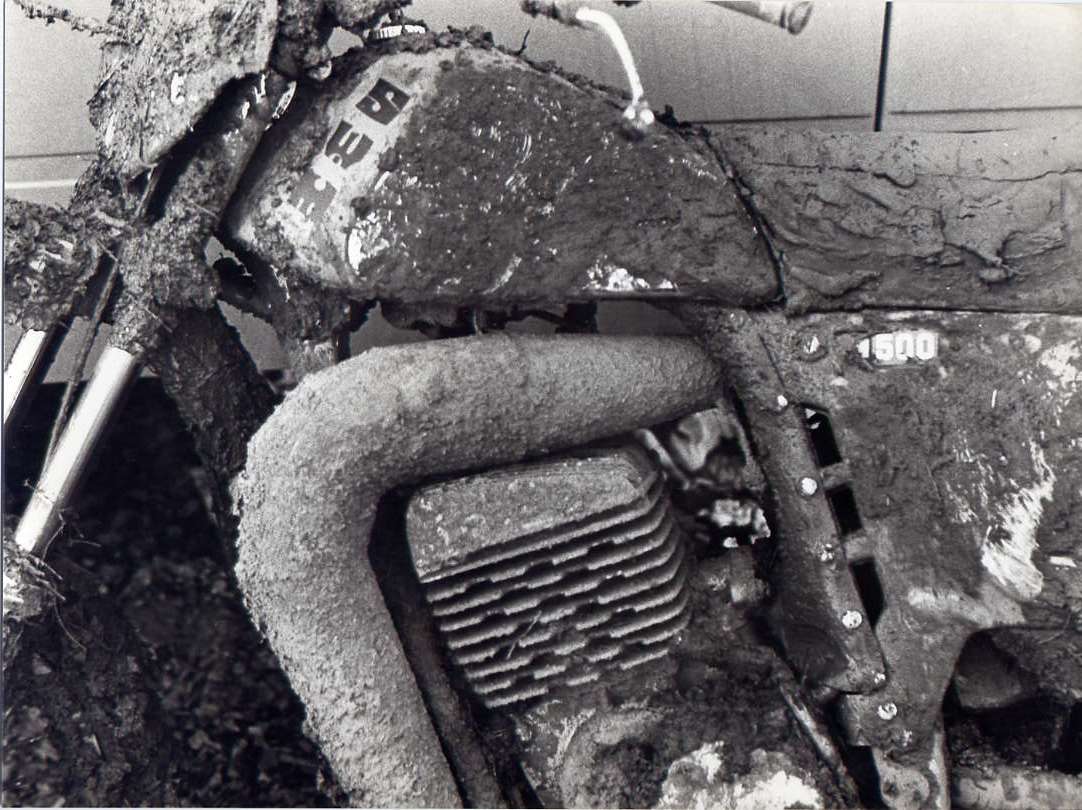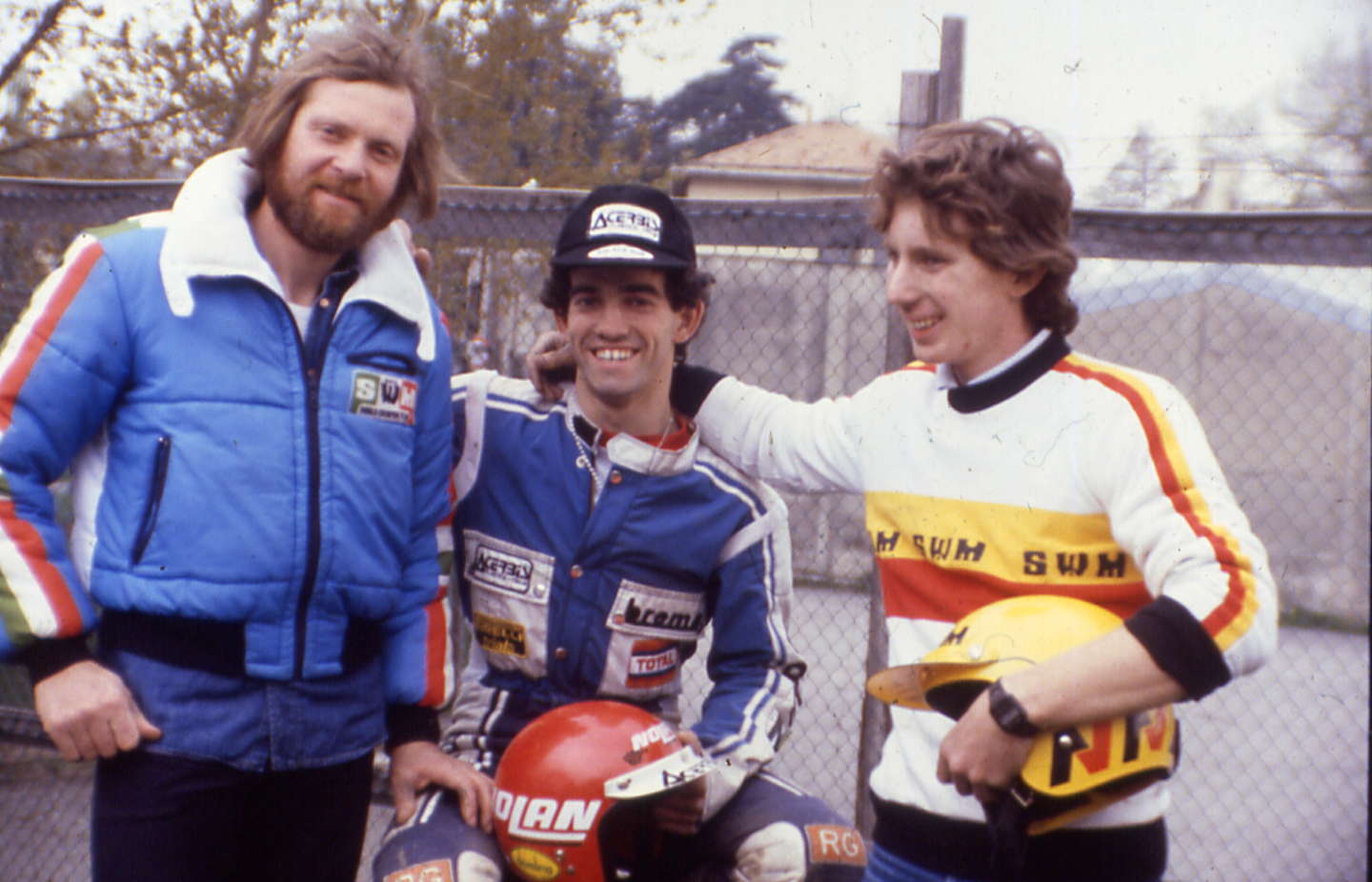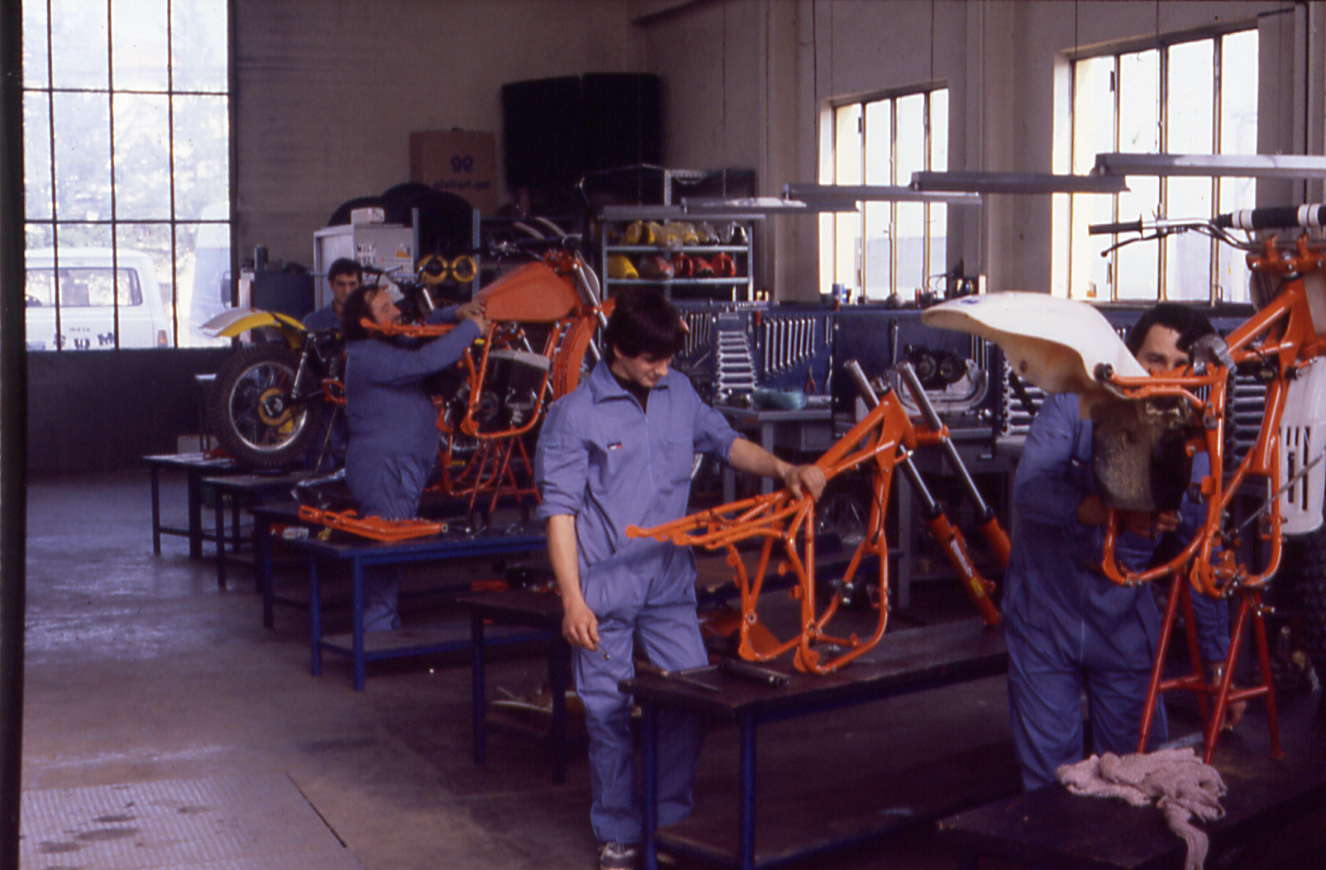SWM HISTORY 4




In this paragraph, we would speak about the historical age of SWM between the 1979 and the 1980 that was one of the best periods both in the sports range and in the commercial range. The SWM production started with 900 pcs of the 1973 and evolved with 1750 pcs in 1974, 2500 pcs in 1975, 3000 pcs in 1976, 5000 pcs in 1977 and 6000 pcs in 1978. With the new was presumable another increase, seen the good trend of the market. Pushed by this wave of optimism the technical staff and the SWM run department, after the Swedish Six Days of the ’78 got to work to study the models of the new section.
On the basis of the reached experiences with the RS-GS series, which had presented some lacks in the triangulation of the undercarriage, in the superior junction of the shock-absorbers and on the geometry of the posterior suspension, was prepared a new model named RS-GS-TF1 and RS-MC-TF2 that had to mark a further evolution way of understanding the reliability motorbike for the Company of Rivolta d’Adda. In this way started the TF era in which the odd numbers would have highlighted the reliability motorbikes (TF1, TF3) and the even numbers the cross motorbikes (TF2, TF4, TF6). Speaking about the motocross, in anticipation was ended a new model studied especially for the cross towards the end of 1979, SWM prepared an intermediated model with the RS-MC that utilized the cyclistic of the TF1, which characteristics, in addition to utilize a motor, an exhaust and the superstructure right with this discipline, was those one to have the tail of support for the posterior mudguard of cross that heartily recommend immediately behind the saddle and not in half mudguard, like on the reliability model. In the front axle assembly was assembled a staple pivot in axle ZT1 of 35mm and the fuel tank was made in aluminium.
The substantial differences between the RS-GS and the first version of the TF1, in addition to the entry in production of a new cubic capacity with the already tested motor of 347cc with lamellar admission, in the cyclistic then reguarded mostly the suspensions: formerly was utilized the new staple of Marzocchi ZT1 feather with the scabbard mode in magnesium and the inferior “V” plate, whereas on the rear were seed the new shock-absorbers of Corte and Cosso with separated tub. The undercarriage, also preserving unchanged the former split single beam structure, was upset on the rear: the shock-absorbers were took back in a vertical position with junctions that remembered which ones of the Silver Vase, the staple was replaced with one of a new banana design (very popular in those times) and of a circular section. In the superior zone were some big additional supports boxed that act as also like junctions for the shock-absorbers. In the undercarriage disappeared the big junctions for the raised platform instead of some new rational and light, whereas for the new model of 347cc was increased the section of the pipes.
For the minor cubic capacity were revised the motor, the suctions and the exhaust. The propellers were improved in the clutch increasing the number of the disks and were inserted 3 sphere on the pressure plate to reduce the surface of friction, on the 125cc was also completely revised the cylinder that now presented with 5 decanting with the reed made in cast iron and carburettor by Mikuni, whereas on the 175cc and the 250cc were revised the diagrams; on the suction was used a new air box made in plastic material more resistant and printed with a new system named “in rolation”, on the 175cc and the 250cc was utilized a new carburettor by Dellorto as a replacement for the old Bing that gave scarce possibilities of calibration. In the end on the exhaust were completely revised the silencers and the pot for all the cylinders.
In addition, the superstructures made in plastic were completely reshaped: the former mudguard presented itself more wrapping and it followed better the bend of the wheel; on the posterior appeared a spoiler parasplash; the sides were completely reshaped like the former cover light box.
The colouring on the 125cc, 175cc and 250cc remained white/red whereas for the 347cc, having the propulsor in a different colouring, was chosen a livery white/orange. The first models of TF1/2, in the 125, 175, 250, 347 cilindrics both cross, and reliability, were commercialized in April 1979 whereas the 347cc get in production only in October.
As upfront, the absolute novelties of this series were the new motorbikes of 350cc with mixed suction motor: traditional in the cylinder and lamellar in the carter. The actual cilindrics of 347,37cc is dude to the diameter of 82mm of the piston and to his run of 66mm that gave also the initial of the motorbike
RS 347 GS TF1.
The tests of the new motor were done during the 1978 by the testers of the SWM experience department disputing with Lavetti some races of the European Championship, coming absolute 10, and of the Italian one in which even coming absolute 4° he could not be awarded because initially was registered in the 125cc class. The new propeller used in that tests had the carters and the cylinder matted on earth and was assembled on the cyclistic of the RS-GS.
In the 1979 agonistic season, seen the dependability of the new motor of 350cc and his imminent get in production, SWM registered Guglielmo Andreini in the 500cc class both for the Italian Championship of cross and for the reliability and European Championship. At the start of the year he disputed the first races of the Italian Championship of cross with a motorbike equipped with the 280cc motor with rotating suction and assembled on the undercarriage RS-MC but with a new “banana” swingram (like the one used later on the TF1), later on, when was ready the RS-347-MC TF1 and the increased 370cc, ended the season winning the championship, breaking the rival Forni on Montesa.
In the reliability championship he started from the beginning with the new motor disputing the first races still with the matted on earth prototype and then going to the definitive one, also asserting himself on everybody in the European Championship and coming 4° in the Italian one.
Not less behaved the rest of the riders that composed the run team of SWM in the 1979 whom, in the saddle of the new models TF1, did the amplain of the European Championship winning also 125cc with Brissoni, the 175 with Marinoni and the 250cc with the new getting Gualdi. In the Italian Championship in addition to win the Championship for industry teams, Brissoni won the 125cc and Gualdi the 250cc, whereas Marinoni came second in the 175cc. The “ icing on the cake” SWM put it in occasion of the 54° International Six Days in Neuenkirchen in Germany where Italy won the trophy with a mixed team composed by 3 SWM riders and 3 KTM riders, placing also Marinoni first in the 175cc, Andreini first in the 500cc, Gualdi and Brissoni seconds respectively in the 250cc and in the 350cc.
Even in the reliability, SWM gathered another important result with a young boy very promising named Edy Orioli who on the saddle of a Silver Vase 50 won the Italian Championship of cadet.
Falling back another time to the cross, in addition to the positive year of Andreini, who won the 500 Senior Italian Championship, another important finishing post was the victory of the Belgian Championship of 250cc Senior of Jean Claud Laquaye who after a fought season had the best on Jobè Everest and Gaston Rahier at the latest race. Also in the World Championship of 250cc J.C. Laquaye, assisted by the Belgian importer Joel Robert, came 8° with a motorbike of perfectly series.
For what regard the trial SWM in 1979 substantially kept the same motorbikes presented at the “Salone del Ciclo e Motociclo” (Intenational bycicle and motorcicle show) of 1977 which were done some betters and updates suggested by the experience maturated in the competitions. The run department SWM-TRIAL in 1979 in addition to point another time on his peak riders, Galeazzi, Tosco and Coutard, applied himself in following some promises of the national and foreign trial, supplying on adequate assistance in the preparation of the motorbikes and on the competition field. Thanks to this policy SWM won the third place with Galeazzi and the fourth place with Tosco in the Italian Senior Championship in 1979; the first with Romegialli and the second with Maltry in C.I. Junior; the first place with Charles Coutard in the French Championship Senior category and the first place with Gilles Bourgat Junior category and finally two second places of Timo Ryysy respectively in the Finnish and Scandinavian Senior Championship.
In 1979 the mechanics of the run department were committed not little in the development of the motorbike because of the fussiness of Coutard who came literally in the garage and he did continuously vary the geometry of the undercarriage, moving the platforms in all the possible and presumable positions, raising and lowering the centre of gravity, varying the inclination of the steering and the position of the handle bars. At the end came out a new undercarriage that had the double cradle monobeam that ended immediately after the front junction and raised more a big bumpers made in aluminium under the motor.
In occasion of the 46° “MOTOSALONE DEL CICLO E MOTOCICLO” (International Bycicle and motorcycle show) of the end of November 1979 SWM renewed much of these products and introduced some news like, for example, the GTS RACING: a new motorbike nonconformist and against the tide, that in those times was not understood but some years leather gave the inspiration to the vain of the ENDURANCE/ SCRAMBLER on the wave of the Decariane’s competitions.
Starting from the idea of realising a motorbike adopted to all the activities, rood racers and off road racers, that made little noisy and that was adopted to everybody, SWM realised a motorbike equipped with a trial motor revised in the suction and in the exhaust and with a cyclistic derived from that one of the TF1 of reliability, all seasoned with some suitable superstructure and on the electrical system.
Overall came out a pleasant to see for the blue-black colouring and the many chromate parts, but also intended above all in the use with passenger and in the off-road. The unique neo was the speed that was not excessive, hardly surpassed the 100 km/h and so in the road use was always to throttle with consequent high consumption of fuel.
Always at the “Motorshow” of 1979 SWM presented the renewed brand of TF2 cross that, abandonee the old undercarriage TF1 type, utilized a new structure especially realized for this discipline, like suspensions on the front axle assembly were assembled some staples feather of Marzocchi leading spindle, whereas in the rear were, of series, some shock-absorbers of Corte and Cosso that the customer could substituting in phase of order with some Hollins, Fox or Marzocchi, like optional. For the new TF2 cross was chosen an orange colouring from the undercarriage to the plastics and to the motors on the 370 and the 440 whereas the 125 and the 250 remained black. Was also realised a new fuel tank in shockproof plastic and new superstructure. The undercarriage was completely upset compared with the old TF2: maintaining a mono-splitted-beam structure was revised the headstock and the two uprights; in the rear were revised the junctions for the shock-absorbers and his triangulature, whereas on the “banana” staple disappeared the big boxed junction for the shock-absorber.
Few were the changes for the TF1 of reliability that were revised only in the colouring on the 125cc, 175cc and 250cc, adopting the livery orange/ white/ black like on the 347cc and the 370cc.
Motoring the most important changes concerned the 125cc with the adopting of a new cilindrics chrome barrel made in nikasil 5-racing more two boosters in the exhaust and the utilize of a fuel by DELLORTO PHBE 34.
In addition, the trial’s range, that, in that moment, was named TL N, was completely revised adopting the new undercarriage developped by Coutard & C., some new shock-absorbers Corte and Cosso and for the livery was chosen the yellow colouring for the superstructure and black for the cyclistic.
From price list were the six and seven gars Silver Vase 125cc, 175cc and 250cc models that by that time were produced only in the economic version named “Regolarità” with the rims made in iron, not sophisticated suspensions, motor of series and white/red colouring like for the RS-GS.
Also the old RS-GS continued to remain in production but only in the GSL version (due to new type of approval adopted since the 1979 that was not more a declaration of conformity that ends after 10 years but a certificate of conformity with unlimited validity), in the classic white and red colouring more a yellow/black colouring, like for the trials and intended only to the French market like the cilindrics of 240cc. The undercarriage adopted on the GSL undergone an improvement in the junction of the shock-absorbers whereas disappeared the top stud, was increased the section of the tubes and were applied 4 big hankies of reinforcement to the inferior ropes.
Always at the “Motorshow” of the 1979 was presented the new range of mopeds LA’ with the printed undercarriage, in the vary versions: with wheels of 16” in league or ryes, single saddle or long with trunk, lights, odometer and variator.
Another novelty of the end of 1979 was the collaboration and the sharing in stock of SWM in the Florence Gori whom were provided the SWM-ROTAX motors for the preparation of new motors of cross and reliability presented at the “Motorshow” of Milan, in addition to the supply of some models of trial that, colored in green, were sold with this mark. In 1980 Gori commercialized also a discreet number of Silver Vase 50 in the no-registered version, (code) and 5 gears motor.
After the happy regolaristic year of 1979, when won all that could be won, and the unexpected success in the Italian, Belgians and world championships of cross, SWM decided to enter seriously and officially also in this discipline. In this regard were engaged like first driving J.C. Laquaye, to dispute the World Championship of 250cc of 1980, and for the Italian Championship the promising Dal Brun who, when possible, would have disputed also some tests in the World Championship. In addition to these ones, also the various Andreini, Brissoni, Marinoni ecc.. would have continued to dispute some races of cross like training and preparation to the reliability.
When were defined the commercial and sportive strategies for the 1980 the management staff of SWM threw himself headlong in the continuous evolution of the firm starting the construction of a new building that had to group the two lines of production of XXV Aprile street in Rivolta d’Adda and of Guardamiglio (Pc), the warehouse of Baldasco, part of the administrative offices of Palazzolo Milanese and the run department that at that moment was situated in Treviglio far away from prying eyes. The technicians and the riders, their part, began to work immediately to prepare the motorbikes to use in the new agonistic season.
Focusing over the trial, SWM, for the 1980, sided a strong team for the World Championship, composed by Bourgat, Desnoyers, Galeazzi and Coutard, who by the end of the season would have left the SWM to pass to the Montesa, maybe followed in the entry in the team of Lampkin, passed to SWM after a tempestuous starting of the season with Bultaco.
Unfortunately ran the greedy occasion of lead also Schreiber who at the end of the trading of the sportive director SWM, Kuciukian, preferred the colours of the new Italjet successor in the production of the Iberia trial. However at the end of year the things didn’t go so wrong seeing that Lampkin came 5° in the World Championship and with SWM brought the 2 second places in Germany and Italy, Bourgat 11°and Galeazzi 15°, first of the Italian patrol. In the Italian Championship went ever better and SWM gained his first national Senior title that corresponded also to the first title all Italian in absolute: rider-motorbike. Also in the 125cc, reserved to the only Junior riders, SWM won the Italian Championship with the good Ponzi.?????????????
In the cross the things gone enough good if we take into a count that was the first year that SWM sided officially in this discipline. In the World Championship of 250cc the new purchase Dal Brun came 5° and Brissoni 12° whereas in the 500cc, Andreini came 8°.
In the reliability the things continued to evolve for the best and the SWM team imposed itself still above everyone many times during the Championship of 1980. In the European Championship, abandoned finally the 50cc, 100cc and 175cc classes, because they were intended to the abolition, SWM devoted himself completely to the 125cc with Brissoni who won the Championship, like Marinoni in the 250cc and Andreini in the 500cc. At the Six Days made in France, Italy sided in the trophy a mixed team with SWM (Marinoni250cc, Brissoni 350cc, Andreini 500cc) and KTM (Andrioletti 250cc, Taiocchi 350cc, Croci 500cc) that came 1°; singly the 3 SWM riders came: Andreini 1°, Marinoni 2°, Brissoni 3°; whereas like industrial team SWM came 2°.
In the Italian Championship the things didn’t go worse and the trio of SWM came in the absolute: 1° with Brissoni, 3° with Andreini and 4° with Marinoni; in the single classes Brissoni won the 125cc on Gualdi passed to the Fantic and Andreoletti with KTM. Marinoni came 2° in the 250cc wrought by found Gritti with the new Kramer, but beating Croci on KTM. In addition, Andreini finished 2° in the 500cc in favour of Taiocchi on KTM.
The motorbikes used in 1980 by the official riders of SWM were some TF1 that already outlined what must be the series for the 1981. They become as completely orange, adopting initially the fuel tank and then the superstructure, the shock-absorbers Corte and Cosso in separate bowl were replaced with some new experimental types Compact or with some Marzocchi AG4 with sheaths made with magnesium. Many attention was given to the lightening of the whole motorbike, some particulars like the platforms, pedal of the posterior brake were lightening; spacers, anchors and dice of big diameter were made in aluminium and the carters motor entirely excavated eliminating all the fins and no-essential parts.
In particular the 125 of Brissoni, that in 1980 won both the Italian Championship and the European was a proper masterpiece; defining it like a gruyere, it had holes of lightening everywhere in the undercarriage, in the motor, but not made at random so as compromising the reliability. A proper masterpiece was the brake drum crown box of the posterior decomposable brake that had a hundred of hides of lightening on the external part; the motor was also very lightened with holes at the pinion at the clutch, at the lever of the starter that had been also shortened, the dices of fixing of the bell and of the pinion were made in aluminium. The motor with the cylinder made in nikasil, also being of series, had all the conducted polished mirror and the carters completely made in titanium, from the pins to the dices to the bolts and all the screws; the spacers, the eyes, the compasses made in aluminium like fund of the saddle. Luckily this motorbike escaped and after being disassembled for many years in pieces a little here and a little bit there on the shelves of Sironi’s house, his son Mauro that had used it in the Italian Junior Championship of 1981 succeeded to transmit together and now makes a fine show in his personal museum.


